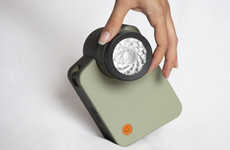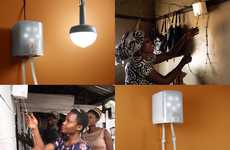
Replacing Kerosene Lamps with Solar Ones
Bianca — February 22, 2012 — Social Good
References: trendhunter
In January we profiled a social enterprise called One Million Lights, which sells rechargeable solar lights to developing nations. Their goal is to create a more environmentally-friendly and safer alternative to dangerous kerosene lamps by replacing them with one million hand-held solar lamps.
We had a chance to catch out with the founder, Anna Sidana. In the interview below, Ana shares where the idea for her ambitious project came from, and how she keeps herself motivated on this challenging -- but world-changing -- social venture.
3 Questions with Anna Sidana, Founder of One Million Lights
1. How did the idea for the business model come about?
We learned through experience. After starting with a completely donation-based model we evolved into a more of an 'entrepreneur' based business model. The donations still play into our business model because that helps us subsidize the price of a solar light to a level that is affordable in the remote regions where we distribute. However, our goal is to create a sustainable supply chain that can reach the people who need this the most. The retail price of a solar lights ranges from $25 - $50 and often that is too high for a family living at subsistence level. In most regions where we deliver the lights, the families live on less than $2-$5 per day.
2. How did you decide to join this sector?
It was quite by accident that I ended up starting a nonprofit. I was inspired by a visit to a village school that my father had founded some 45 years ago in Rajasthan, India. I was inspired by the village children who were so bright, motivated and excited at the prospect of education and advancing themselves. These children lived in a rural. agricultural setting with no access to reliable electricity but they wanted to become doctors and engineers and teachers. I felt like doing something for them.
When I returned from my trip, I coincidentally became a mentor to a group of students at Stanford who were designing a solar lamp. One thing led to another and I decided to start One Million Lights with a view that the need is vast and global. I still work full-time in high tech but love working on One Million Lights in my spare time.
3. How do you reset yourself to be creative? Do you have any rituals?
No, I don't have any particular rituals. But I do step out of the corporate world and the role of a CEO to take vacations with my family and two children. I also exercise regularly, do art for fun and enjoy a good movie!
If you're on Twitter and want to help support One Million Lights, you can follow their updates @millionlights.
We had a chance to catch out with the founder, Anna Sidana. In the interview below, Ana shares where the idea for her ambitious project came from, and how she keeps herself motivated on this challenging -- but world-changing -- social venture.
3 Questions with Anna Sidana, Founder of One Million Lights
1. How did the idea for the business model come about?
We learned through experience. After starting with a completely donation-based model we evolved into a more of an 'entrepreneur' based business model. The donations still play into our business model because that helps us subsidize the price of a solar light to a level that is affordable in the remote regions where we distribute. However, our goal is to create a sustainable supply chain that can reach the people who need this the most. The retail price of a solar lights ranges from $25 - $50 and often that is too high for a family living at subsistence level. In most regions where we deliver the lights, the families live on less than $2-$5 per day.
2. How did you decide to join this sector?
It was quite by accident that I ended up starting a nonprofit. I was inspired by a visit to a village school that my father had founded some 45 years ago in Rajasthan, India. I was inspired by the village children who were so bright, motivated and excited at the prospect of education and advancing themselves. These children lived in a rural. agricultural setting with no access to reliable electricity but they wanted to become doctors and engineers and teachers. I felt like doing something for them.
When I returned from my trip, I coincidentally became a mentor to a group of students at Stanford who were designing a solar lamp. One thing led to another and I decided to start One Million Lights with a view that the need is vast and global. I still work full-time in high tech but love working on One Million Lights in my spare time.
3. How do you reset yourself to be creative? Do you have any rituals?
No, I don't have any particular rituals. But I do step out of the corporate world and the role of a CEO to take vacations with my family and two children. I also exercise regularly, do art for fun and enjoy a good movie!
If you're on Twitter and want to help support One Million Lights, you can follow their updates @millionlights.
Trend Themes
1. Solar Lamp Distribution - Opportunity to disrupt traditional kerosene lamp markets by providing affordable and eco-friendly solar lamps to remote areas.
2. Nonprofit Entrepreneurship - Disruptive innovation lies in creating sustainable business models for nonprofit organizations, relying on both donations and profit generation.
3. Socially Conscious Technology - Leads to market disruption by creating innovative and affordable tech devices that solve social and environmental issues in underprivileged communities.
Industry Implications
1. Renewable Energy - Companies in this industry can expand to create affordable and portable renewable energy solutions for remote and poor communities in developing nations.
2. Nonprofit - Disruptive innovation opportunity lies in creating sustainable business models by combining charitable donation with profit-generation for societal good.
3. Technology - Opportunities to create technology that solves social and environmental issues in underprivileged areas by providing affordable and sustainable products.
3.5
Score
Popularity
Activity
Freshness























